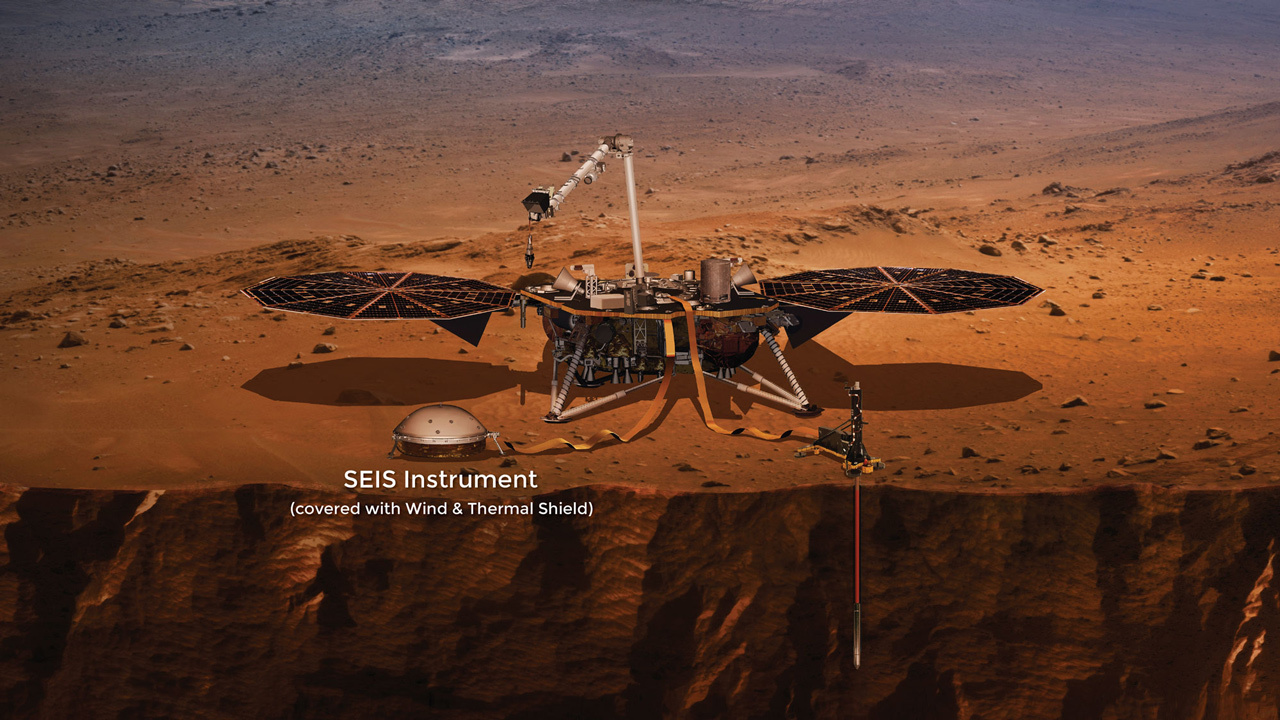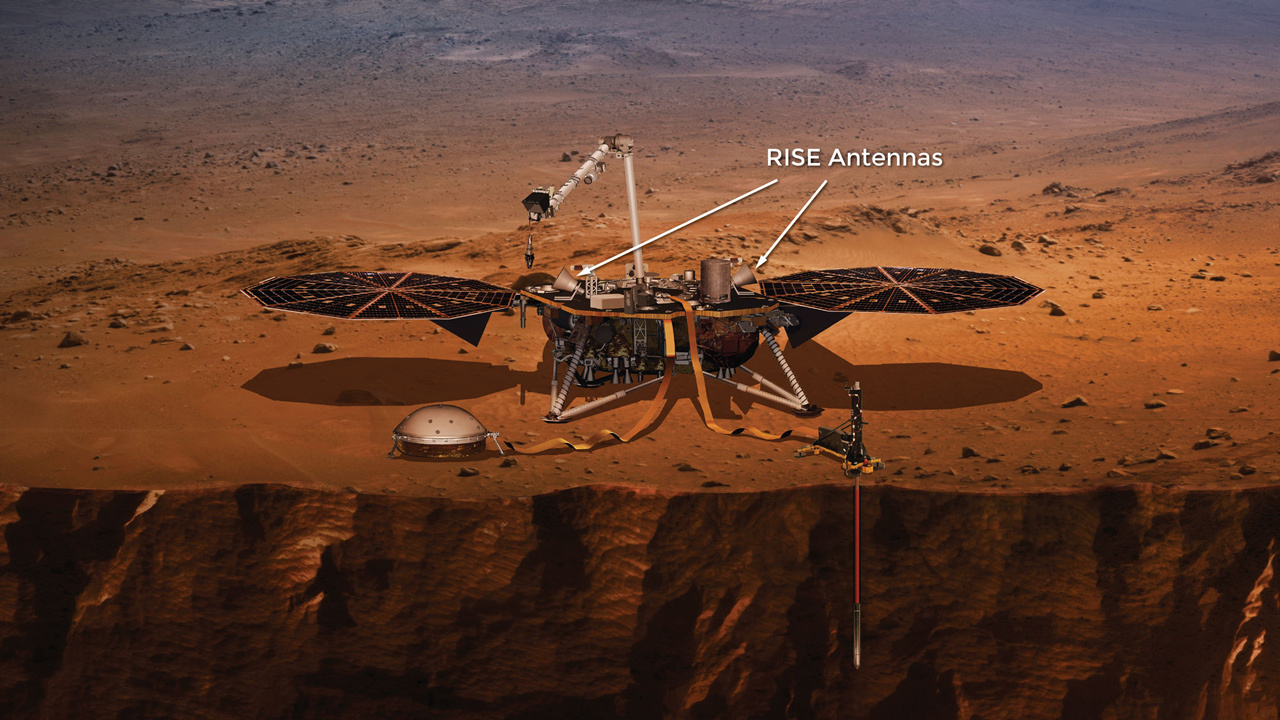On the day that InSight landed, there were three images taken (two from Instrument Context Camera (ICC) and one from Instrument Context Camera (ICC)). Now, there are 46 images taken! The latest image is below from the Instrument Deployment Camera (IDC). There are 17 images taken on Sol 10 - 7 December 2018. The image was taken on Sol 10 (day 10 on Mars = 20 Earth days), on 7 December 2018, 12:52:42 PM.

Let's know about InSight's instruments. InSight has three instruments, the first one is a Seismometer.
InSight's Seismometer, SEIS (Seismic Experiment for Interior Structure) is a round, dome-shaped instrument that sits on the surface of Mars, which takes the pulse or seismic vibrations of Mars. The measurements provide information about Mars' internal activity. The Seismometer waits to sense the marsquakes (mars instead of earth - earthquakes) and seismic waves. SEIS measurements inform scientists about the nature of the material that formed the rocky planets of our Solar System. This reveals what is beneath Mars, also, the Seismometer might even inform if there are active volcanoes, liquid water or plumes which are underneath the surface of Mars. The main job of the Seismometer is to measure the pulse of Mars, by studying waves created by Marsquakes.
Below is a video from National Geographic. Knowing about InSight taking Mars' pulse.
Did you know that the SEIS seismometer is so sensitive, it can detect surface movements smaller than a hydrogen atom!?
Here are five facts that you need to know:
- The seismometer can sense weather phenomena like, dust storms that produce seismic waves.
- Scientists expect from the seismometer to detect five to ten meteor impacts over the InSight mission.
- The InSight lander delivers the first seismometer to Mars in the first 40 years. The last time seismometers travelled to Mars was with the Viking landers.
- InSight's SEIS seismometer is like a doctor's stethoscope, like a doctor listening to the patient's heartbeat, SEIS listens for marsquakes.
- The SEIS is ultra-sensitive that can tune in to tremors smaller than a hydrogen atom!
So these are some five amazing facts about the SEIS. We all know what are Earthquakes, right? But, do you know what are Marsquakes? Here is a video from JPL from the series, Mars in a Minute, about Marsquakes. It's just only a minute long.

The next instrument is called the Heat Probe. The Heat Flow and Physical Properties Probe, (HP3). Which makes a hole down to almost five meters. The HP3 takes Mars' temperature, which reveals how much heat is flowing out of the inside of the planet. The mass of HP3 is just over 3 kilograms. The maximum power of the HP3 is about 2 watts while digging underneath the surface.
Here are five facts that you need to know about the HP3.
- HP3 tells scientists how heat flows inside Mars.
- HP3 takes the temperature of the interior of Mars.
- Information from the heat flow reveals if Earth and Mars are formed from the same stuff, also, how active Mars is.
- HP3 package has a probe that digs down up to 5 meters below the surface. That's deeper than previous instruments to any other moon, planet or asteroid, which have only dug up the upper inch of rock or soil.
- HP3 pulls the ribbon-shaped cable behind it, that's jam-packed full of temperature sensors.

Our third and final instrument is called the Radio Science Experiment. The Rotation and Interior Structure Experiment (RISE), 'tracks the location of the lander to decide just how much Mars' North Pole wobbles as it orbits the sun.' This observation will include detailed information about the size of Mars' rich core. The main job of RISE is an apostrophe. The location of RISE is two Medium-Gain 'horn' Antennas (MGAs) on InSight's deck. The mass is about 7.3 kilograms. The antennas are about 1.4 kilograms.
Here are five things that you need to know:
- RISE tracks the location of InSight lander every day, which also knows its location to within a few centimetres.
- RISE simply sends back the signal sent to the lander from Earth, via the Deep Space Network, revealing InSight's location.
- As the seasons change on Mars, carbon dioxide controls and shortens at the poles, causing tiny changes in the rotation rate of Mars, affecting the length of Mars' day. RISE will be able to measure these changes.
- RISE will help control if Mars has a solid metal core, like a hard-boiled egg, or a molten, liquid metal core, like a soft-centred, raw egg.
- RISE uses the same principle that causes the sound from a fast-moving siren to change as it moves away, to study Mars' core.
That's a lot of information about instruments that InSight has and I hope you learnt heaps of information about InSight's instruments. If you want to see how the instruments work. There is a 3D view of InSight by NASA named 'Experience InSight'. You can move the camera and more other fun things.
NASA has a press-kit which shows information that I don't have. The press-kit includes the following:
- Introduction
- Media Services
- Quick Facts: Landing Facts
- Quick Facts: Mars at a Glance
- Mission: Overview
- Mission: Spacecraft
- Mission: Science
- Mission: Landing Site
- Program & Project Managment
- Appendix: Mars Cube One Tech Demo
- Appendix: Gallery
- Appendix: Science Objectives, Quantified
- Appendix: Historical Mars Missions
- Appendix: NASA's Discovery Program
The press-kit has heaps and heaps of information, that you might even don't know about.
If you haven't seen the landing of InSight. It had streamed one week ago. Below is a 1 hour, 30-minute live stream video about the landing. It's a long video, right? Below the live stream, there is a video, which is just only 1 minute 38 seconds long.
If you haven't seen the landing of InSight. It had streamed one week ago. Below is a 1 hour, 30-minute live stream video about the landing. It's a long video, right? Below the live stream, there is a video, which is just only 1 minute 38 seconds long.
So before I wrap it up, I will tell what I've learnt and it is a lot of information that I've learnt.
What I've Learnt
- Now there are 46 images taken since the landing.
- The latest image is below from the Instrument Deployment Camera (IDC).
- There are 17 images taken on Sol 10 - 7 December 2018, 12:52:42 PM.
- InSight has three instruments: Seismometer, Heat Probe and Radio Science Experiment.
- InSight's Seismometer, SEIS (Seismic Experiment for Interior Structure) is a round, dome-shaped instrument that sits on the surface of Mars, which takes the pulse or seismic vibrations of Mars. The measurements provide information about Mars' internal activity.
- The Seismometer waits to sense the marsquakes (mars instead of earth - earthquakes) and seismic waves.
- SEIS measurements inform scientists about the nature of the material that formed the rocky planets of our Solar System.
- This reveals what is beneath Mars, also, the Seismometer might even inform if there are active volcanoes, liquid water or plumes which are underneath the surface of Mars.
- The main job of the Seismometer is to measure the pulse of Mars, by studying waves created by Marsquakes.
- The SEIS seismometer is so sensitive, it can detect surface movements smaller than a hydrogen atom!?
- The seismometer can sense weather phenomena like, dust storms that produce seismic waves.
- Scientists expect from the seismometer to detect five to ten meteor impacts over the InSight mission.
- The InSight lander delivers the first seismometer to Mars in the first 40 years. The last time seismometers travelled to Mars was with the Viking landers.
- InSight's SEIS seismometer is like a doctor's stethoscope, like a doctor listening to the patient's heartbeat, SEIS listens for marsquakes.
- The SEIS is ultra-sensitive that can tune in to tremors smaller than a hydrogen atom!
- The Heat Flow and Physical Properties Probe, (HP3).
- Which makes a hole down to almost five meters.
- The HP3 takes Mars' temperature, which reveals how much heat is flowing out of the inside of the planet.
- The mass of HP3 is just over 3 kilograms.
- The maximum power of the HP3 is about 2 watts while digging underneath the surface.
- HP3 tells scientists how heat flows inside Mars.
- HP3 takes the temperature of the interior of Mars.
- Information from the heat flow reveals if Earth and Mars are formed from the same stuff, also, how active Mars is.
- HP3 package has a probe that digs down up to 5 meters below the surface. That's deeper than previous instruments to any other moon, planet or asteroid, which have only dug up the upper inch of rock or soil.
- HP3 pulls the ribbon-shaped cable behind it, that's jam-packed full of temperature sensors.
- The Rotation and Interior Structure Experiment (RISE), 'tracks the location of the lander to decide just how much Mars' North Pole wobbles as it orbits the sun.'
- This observation will include detailed information about the size of Mars' rich core.
- The main job of RISE is an apostrophe.
- The location of RISE is two Medium-Gain 'horn' Antennas (MGAs) on InSight's deck.
- The mass is about 7.3 kilograms.
- The antennas are about 1.4 kilograms.
- RISE tracks the location of InSight lander every day, which also knows its location to within a few centimetres.
- RISE simply sends back the signal sent to the lander from Earth, via the Deep Space Network, revealing InSight's location.
- As the seasons change on Mars, carbon dioxide controls and shortens at the poles, causing tiny changes in the rotation rate of Mars, affecting the length of Mars' day. RISE will be able to measure these changes.
- RISE will help control if Mars has a solid metal core, like a hard-boiled egg, or a molten, liquid metal core, like a soft-centred, raw egg.
- RISE uses the same principle that causes the sound from a fast-moving siren to change as it moves away, to study Mars' core.
- There is a 3D view of InSight by NASA named 'Experience InSight'.
- The press-kit includes the following:
- Introduction
- Media Services
- Quick Facts: Landing Facts
- Quick Facts: Mars at a Glance
- Mission: Overview
- Mission: Spacecraft
- Mission: Science
- Mission: Landing Site
- Program & Project Managment
- Appendix: Mars Cube One Tech Demo
- Appendix: Gallery
- Appendix: Science Objectives, Quantified
- Appendix: Historical Mars Missions
- Appendix: NASA's Discovery Program
I hope you like my post about the update on InSight Robotic Lander. Comment down below if you've learnt something on my post. Stay tuned to see my posts in the holidays (starts from 17 November) about the Summer Learning Journey 2018-19. Have a cool day!! Bye!!